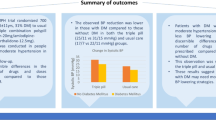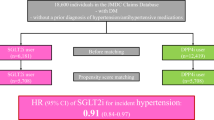Abstract
Hypertension and lipid disorders in type II diabetes contribute to increased coronary risk, but optimal drug therapy has not been defined. We investigated primary care physicians choices of antihypertensive and lipid-lowering therapy for subjects with type II diabetes diagnosed with hypertension. Subjects were registered with 105 UK general practices in the General Practice Research Database and prescribed oral hypoglycaemic drugs for the first time between January 1993 and December 2001. We evaluated prescriptions for antihypertensive drugs in subjects with secondary diagnoses of hypertension in the first year following initiation of oral hypoglycaemic therapy. Data were analysed for 4519 diabetic subjects with diagnosed hypertension. Between 1993 and 2001, the proportion prescribed thiazide diuretics increased from 20 to 30%; angiotensin-converting enzyme (ACE) inhibitors from 35 to 45% and angiotensin receptor blockers from 0 to 8%. The proportion of subjects prescribed lipid-lowering therapy increased from 8% in 1993 to 33% in 2001, with the proportion prescribed statins increasing from 1 to 30%. At different general practices, the proportion prescribed thiazide diuretics ranged from 0 to 52%, beta-blockers from 5 to 60%, ACE inhibitors from 15 to 81%, and statins from 0 to 50%. Variation between practices was not explained by adjusting for age, sex, prevalent coronary heart disease or study year. Trends in drug utilisation were consistent with the evolving evidence base but there were wide variations in drug utilisation between practices. A more consistent approach to drug selection might be associated with improved patient outcomes.
This is a preview of subscription content, access via your institution
Access options
Subscribe to this journal
Receive 12 digital issues and online access to articles
$119.00 per year
only $9.92 per issue
Buy this article
- Purchase on Springer Link
- Instant access to full article PDF
Prices may be subject to local taxes which are calculated during checkout
Similar content being viewed by others
References
Kanaya AM, Grady D, Barrett-Connor E . Explaining the sex difference in coronary heart disease mortality among patients with type 2 diabetes mellitus: a meta-analysis. Arch Int Med 2002; 162: 1737–1745.
Chobanian AV et al. The seventh report of the Joint National Committee on Prevention, Detection, Evaluation, and Treatment of High Blood Pressure: The JNC 7 Report. JAMA 2003; 289: 2560–2572.
National Cholesterol Education Program. Third Report of the Expert Panel on Detection, Evaluation, and Treatment of High Blood Cholesterol in Adults (Adult Treatment Panel III) Full Report, NIH Publication Number 02-5215. National Heart Lung and Blood Institute:, Bethesda, MD, 2004 Source: http://www.nhlbi.nih.gov/guidelines/cholesterol/atp3full.pdf accessed March 23rd 2004.
Williams B et al. British Hypertension Society guidelines for hypertension management 2004 (BHS-IV): summary. BMJ 2004; 328: 634–640.
Scottish Intercollegiate Guidelines Network (SIGN). Lipids and the primary prevention of coronary heart disease, Source: http://www.sign.ac.uk/guidelines/fulltext/40/index.html accessed 23rd March 2004.
UK Prospective Diabetes Study. Tight blood pressure control and risk of macrovascular and microvascular complications in type 2 diabetes: UKPDS 38. UK Prospective Diabetes Study Group. BMJ 1998; 317: 703–713.
Working Party of the International Diabetes Federation (European Region). Hypertension in people with type 2 diabetes: knowledge-based diabetes-specific guidelines. Diabet Med 2003; 20: 972–987.
The ALLHAT Officers Coordinators for the ALLHAT Collaborative Research Group. Major outcomes in high-risk hypertensive patients randomized to angiotensin-converting enzyme inhibitor or calcium channel blocker vs diuretic: the Antihypertensive and Lipid-Lowering Treatment to Prevent Heart Attack Trial (ALLHAT). JAMA 2002; 288: 2981–2997.
UK Prospective Diabetes Study Group. Efficacy of atenolol and captopril in reducing risk of macrovascular and microvascular complications in type 2 diabetes: UKPDS 39. BMJ 1998; 317: 713–720.
Agardh CD et al. Greater reduction of urinary albumin excretion in hypertensive type II diabetic patients with incipient nephropathy by lisinopril than by nifedipine. J Hum Hypertens 1996; 10: 185–192.
Parving HH et al. The effect of irbesartan on the development of diabetic nephropathy in patients with type 2 diabetes. N Engl J Med 2001; 345: 870–878.
Ravid M, Lang R, Rachmani R, Lishner M . Long-term renoprotective effect of angiotensin-converting enzyme inhibition in non-insulin-dependent diabetes mellitus. A 7-year follow-up study. Arch Intern Med 1996; 156: 286–289.
Heart Outcomes Prevention Evaluation Study Investigators. Effects of ramipril on cardiovascular and microvascular outcomes in people with diabetes mellitus: results of the HOPE study and MICRO-HOPE substudy. Lancet 2000; 355: 253–259.
Shepherd J et al. Prevention of coronary heart disease with pravastatin in men with hypercholesterolemia. West of Scotland Coronary Prevention Study Group. N Engl J Med 1995; 333: 1301–1307.
Pyorala K et al. Cholesterol lowering with simvastatin improves prognosis of diabetic patients with coronary heart disease. A subgroup analysis of the Scandinavian Simvastatin Survival Study (4S). Diabetes Care 1997; 20: 614–620.
MRC/BHF Heart Protection Study. Study of cholesterol-lowering with simvastatin in 5963 people with diabetes: a randomised placebo-controlled trial. Lancet 2003; 361: 2005–2016.
National Institute for Clinical Excellence. Management of Type 2 Diabetes — Management of Blood Pressure and Blood Lipids, (Guideline H) National Institute for Clinical Excellence: London, 2004 Source: http://www.nice.org.uk/cat.asp?c=38551 accessed 23 March 2004.
Walley T, Mantgani A . The UK general practice research database. Lancet 1997; 350: 1097–1099.
Jick H . Validation of information recorded on general practitioner based computerised data resource in the United Kingdom. BMJ 1991; 302: 766–768.
Hollowell J . The GPRD Quality of morbidity data. Popul Trends 2000; 87: 36–40.
National Statistics. Key Health Statistics from General Practice 1998, Series MB6 No 2. National Statistics: London, 2000.
British Medical Association and Royal Pharmaceutical Society of Great Britain. British National Formulary, Number 44. British Medical Association and Royal Pharmaceutical Society of Great Britain: London, 2002.
Brown MJ et al. Better blood pressure control: how to combine drugs. J Hum Hypertens 2003; 17: 81–86.
Stata Corporation. Stata Reference Manual. Release 7. Stata Corporation: College Station, TX, 2001.
Williams B . Treatment of hypertension in the UK: simple as ABCD? J R Soc Med 2003; 96: 521–522.
Walley T, Duggan AK, Haycox AR, Niziol CJ . Treatment for newly diagnosed hypertension: patterns of prescribing and antihypertensive effectiveness in the UK. J R Soc Med 2003; 96: 525–531.
Law M, Wald N, Morris J . Lowering blood pressure to prevent myocardial infarction and stroke: a new preventive strategy. Health Technol Assess 2003; 7: 1–106.
Wald NJ, Law MR . A strategy to reduce cardiovascular disease by more than 80%. BMJ 2003; 326: 1419–1424.
Montgomery AA, Fahey T, Ben Shlomo Y, Harding J . The influence of absolute cardiovascular risk, patient utilities, and costs on the decision to treat hypertension: a Markov decision analysis. J Hypertens 2003; 21: 1753–1759.
Acknowledgements
This work was supported by the Charitable Foundation of Guy's and St Thomas' Hospital.
Author information
Authors and Affiliations
Corresponding author
Rights and permissions
About this article
Cite this article
Gulliford, M., Charlton, J. & Latinovic, R. Trends in antihypertensive and lipid-lowering therapy in subjects with type II diabetes: clinical effectiveness or clinical discretion?. J Hum Hypertens 19, 111–117 (2005). https://doi.org/10.1038/sj.jhh.1001787
Received:
Revised:
Accepted:
Published:
Issue Date:
DOI: https://doi.org/10.1038/sj.jhh.1001787
Keywords
This article is cited by
-
Blood pressure control in the setting of diabetes mellitus: new targets, new hope for improvement?
Journal of Human Hypertension (2006)
-
Prevention of cardiovascular disease in clinical practice: The Joint British Societies' (JBS 2) guidelines
Journal of Human Hypertension (2006)



